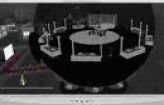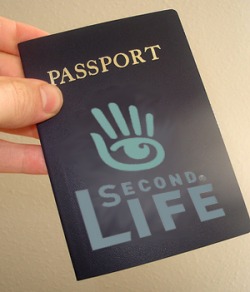Introduction
Greetings and Welcome to our humble blog. The presentation you are viewing was created by Teri Evangelista, Nikie Reyes, and Robert Bruck as a class project for ETEC 649. It is our desire to share with you some of the educational aspects of the virtual world of Second Life. Our goal is to also provide you with enough information to get you interested and even started in Second Life.
Why Virtual Reality in Education?

Currently, virtual reality (VR) is the most advanced form of instructional technology. VR is an innovative new way to teach and engage learners, and provide them an opportunity to step through the computer screen into the 3-D, interactive world. Learners are given the ability to not only enter a new world, but to gain an educational adventure as well. Statistically, students learn best when they areable to approach their subject matterfrom a variety of different modesand viewpoints.
In a traditional classroom, stimulation of learners' imaginations seems to be somewhat limited. In the classroom of today, students are beginning to experience ideas in many differentforms. But, as innovative and encompassing as they are, VR programs are not able to (nor should they) replace the educator or instructor. If there is no formal structure in some form, it is very easy to get side tracked.
What is Second Life?

In a captivating, 3-D format, Second Life is a virtual community created for and by its constituents. Members take up residence, construct an identity, and build an entire life for themselves in the Second Life world, or Grid as they call it. Building the identity is a compelling process that is accomplished by a user designing a customized personage known as an avatar to represent themselves. This virtual world avatar moves about using mouse control and simple keyboard functions.
One of the more interesting features of Second Life is its utilization of sound. Some of the things a visitor or resident is able to experience are audible conversation, the sound of running water, and wind blowing through trees. Also included are communication features such as instant messaging and built-in chat. Users and residents are able to game with other participants, attend classes, buy property, conduct business, create objects, join clubs, or just observe all of the activity.
Second Life as an Educational Tool

An increasing number of school systems, universities and commercial endeavors around the world use Second Life as a supplement or mainstay of their educational and training programs. Second Life’s creator, Linden Lab, collaborates with educational organizations to familiarize them with the benefits of the virtual world. They also strive to connect them with educational peers active in Second Life and share projects and work accomplished in previous projects within the community.
Open source education projects have gained a lot of support from institutions of higher learning, Harvard, Texas State, and Stanford are just a few of the many universities that have set up virtual campuses where their students meet, attend classes, and create content collaboratively.
Educational organizations such as the New Media Consortium (NMC) have embraced Second Life as a professional development medium for educators. NMC has long encouraged shared learning among educators and has promoted learning and creativity related to virtual worlds. Currently they are utilizing Second Life for networking, running seminars, conferences and symposiums.
Some of Second Life’s participants into corporate education include Xerox, IBM and Michelin. Due to their competitive nature, most commercial training has been confined to safety, corporate policy and ethics education and customer relations.
Educational Advantages of Second Life

Second Life provides educational institutions with the ability to expand their capabilities in both an academic and economic sense. An establishment that could not afford the necessary language and science labs now is able to provide learners with the ability to experiment and explore in virtual reality labs at a very affordable cost. The ease at which Second Life is accessible on the same computers already in existence at nearly all educational institutions and homes, means it allows every academic endeavor to greatly improve instruction and increase student achievement.
Second Life Free Campus Program

The Campus Second Life program is a competitive program that is awarded to select lucky bidders each semester. The call for proposals is put out three times a year. Eight projects are selected and given the use of land on the Campus islands to develop their proof of concept. The land is awarded for only a single semester Fall, Spring, or Summer. After the semester is over, Second Life reclaims the plot and awards it to another bidder. In order obtain land and teach a class in the virtual reality world of Campus Second Life, a series of requirements must be met. First, submit a syllabus, schedule, and a proposal on how you plan to use Second Life in the class. Include why Second Life will make a difference to the learning experience you're offering, whether you're planning any research leading to publication, and whether your project is intended as a proof of concept or not. At the end of the semester you will be asked to send Second Life a brief summary of your experience and any insights into what we might do to improve the Campus Second Life program. They will also request copies of any student work that can be shared. If you wish to apply and participate, contact [email protected] using the Subject "Campus Second Life."
Second Life Policy and Rules

Second Life provides a very safe, stable learning environment; it is by design an adult’s only online community, therefore residents and users must be 18 or older. Linden Labs also created a separate virtual world called Teen Second Life designed for users between the ages of 13 and 17. In the past, aspiring residents could simply create accounts in Second Life without submitting an ageverification process that has since been corrected. Conduct is strictly monitored and includes a resident reporting feature which allows all users to report the unwanted or illegal behavior of other users, Second Life Standards lists six kinds of behavior, called the Big Six, which could result in a users suspension or banishment from Second Life if he or she violates them. They are:
Intolerance -- Using derogatory language or images relating to a resident's gender, race, ethnicity, religion or sexual orientation
Harassment -- Stalking another avatar, participating in cyberbullying, using intimidating words or actions, or presenting unwelcome sexual advances toward another avatar
Assault -- Committing an act of violence against another avatar in a Safe area,
Disclosure -- Revealing personal information about another resident
Indecency -- Inappropriate behavior in PG-rated areas, including running around nude or using obscenities
Disturbing the Peace -- Engaging in behavior that is meant to disrupt other residents' experiences in the virtual world. This can include making repetitive, distracting noises or filling a space with so many objects that the area suffers lag as a result.
Getting Started

You might be wondering about Second Life and may want to experience it yourself. Follow these steps to get you up and going.The first thing you need to do to get started is create a Second Life account. Click HERE to start.
** Choose a look. You aren't committed to your look. At any given time you can change the appearance of your avatar. Your avatar's look is always completely customizable.
** Be sure to check on the box next to Choose a Community. You would want to ensure a friendly spawning place for your first experience since as the Second Life Grid is quite large and hectic.
** Continue to fill out the rest of the required information. You are now ready to choose your community and start location. There are a variety of locations as well as languages to start your Second Life experience. Choose the location that interests you most.

 RSS Feed
RSS Feed